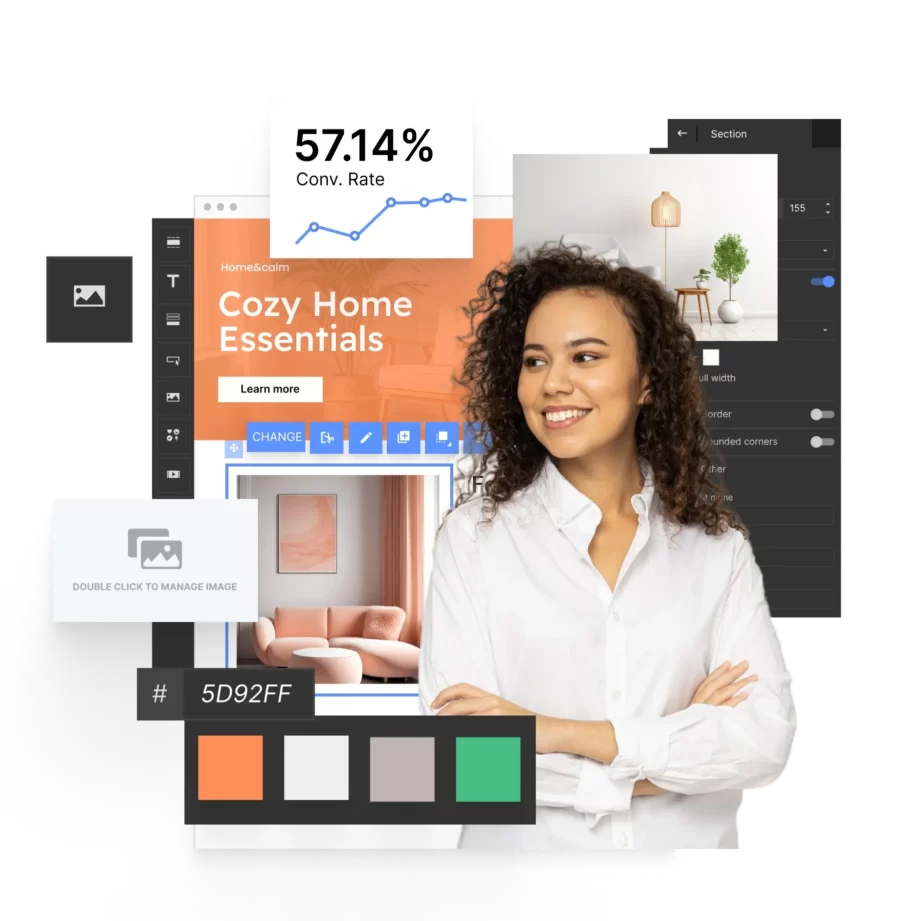Landing page SEO strategically optimizes individual landing pages to improve search engine visibility and drive targeted traffic. With search engines accounting for 68% of online activities and SEO outperforming organic social media by over 1,000% (BrightEdge), a well-optimized landing page is crucial for attracting the right audience and achieving higher search rankings.
In this article, we’ll explore the principles of landing page SEO and share actionable best practices to enhance your page’s visibility, improve user experience, and boost conversion rates. Follow these optimization strategies to maximize the impact of your landing pages and transform more visitors into customers.

What Is Landing Page SEO?
Landing Page SEO refers to the process of optimizing a landing page to rank higher in search engine results pages (SERPs). This involves strategically using relevant keywords, creating high-quality content, improving page load speed, and ensuring mobile-friendly design to make your page more attractive to search engines like Google.

Optimization techniques include:
- Optimizing meta tags, headers, and images with keywords;
- Enhancing the user experience;
- And building quality backlinks.
The Fundamentals Of Landing Page Optimization
Landing page SEO fundamentally aims to enhance visibility in search results and drive targeted organic traffic. Through strategic optimization of content, structure, and technical elements, your pages rank higher for relevant search queries, making them discoverable to potential customers.
Effective landing page optimization focuses on four core objectives:
- Increasing organic traffic by attracting qualified visitors
- Improving conversion rates by enhancing user experience
- Boosting brand visibility across search platforms,
- Supporting marketing campaigns by driving traffic to campaign-specific pages.
The effort pays substantial dividends—the top organic search result captures approximately 27.6% of all clicks, according to Forbes.
What Is a Landing Page?
A landing page is a standalone web page designed to capture leads or drive conversions. It’s typically created for a specific marketing campaign or promotion and is optimized to achieve a particular goal, such as:
- Generating leads – collecting contact information from potential customers.
- Driving sales – persuading visitors to make a purchase.
- Increasing sign-ups – encouraging users to subscribe to a newsletter, webinar, or other service.
Landing pages are often distinct from a website’s homepage and are designed to be more focused and direct. They typically include a clear and concise message, a strong call to action, and relevant visuals, all to direct the user’s attention toward the desired action. Thanks to their focused approach, distraction-free layouts, and persuasive elements, these pages are way more effective than large websites in converting visitors into customers.
Landing pages are essential tools in digital marketing campaigns because, unlike websites, they are tailored to match the specific needs and expectations of the audience. Whether through paid ads, email campaigns, or social media, visitors are directed to a landing page that aligns with the message or offer they clicked on, increasing the chances of conversion.
What Is the Purpose of Landing Page SEO?
Landing page SEO aims to enhance the page‘s visibility in SERPs and drive more targeted, organic traffic to it. SEO optimization, involving strategic changes in content, structure, and technical aspects of a landing page, helps ensure that the page ranks higher for specific, relevant search queries, making it easier for potential customers to find it.
The key goals of landing page SEO optimization include:
- Increasing organic traffic – SEO helps drive more targeted visitors to your landing pages through search engine results.
- Improving conversion rates – it enhances the user experience and makes it easier for visitors to take the desired action (e.g., sign up, purchase, download).
- Boosting brand visibility – SEO helps increase your brand’s online presence and awareness.
- Supporting marketing campaigns – it drives traffic to specific landing pages created for marketing campaigns or promotions.
Overall, the purpose of landing page SEO is to maximize a landing page’s effectiveness by ensuring it’s easily discoverable by search engines and provides value to the users who visit it, leading to more successful outcomes in digital marketing campaigns.
9 Proven Landing Page SEO Best Practices
Landing page SEO best practices that can help you enhance search rankings involve 4 key areas: keyword optimization, content quality and relevance, technical SEO, and link building. These strategies will boost your landing page performance in search engine rankings while simultaneously increasing conversion rates.
1. Implement Strategic Keyword Research
Keyword strategy forms the foundation of an effective SEO approach. It’s all about identifying and targeting the relevant keywords and phrases your audience is searching for.
Start by using keyword research tools like Semrush or Ahrefs to find keywords related to your business, products, or services. When evaluating potential keywords, look at their search volume, competition level, and relevance to your product.
Naturally weave these keywords throughout your landing page content—including the page title, headings, subheadings, and body text. Consider using long-tail keywords (specific phrases that typically have less competition) while avoiding keyword stuffing, which can hurt your rankings rather than help them.
In the US, there are over 19,000 high-volume keywords with at least 100,000 monthly searches, as reported by Ahrefs. Target these keywords, but don’t overlook niche or less competitive ones.
Monitor your keyword performance using analytics tools to track rankings, click-through rates, and conversions. Use this data to make informed adjustments to your strategy over time.
2. Focus on User Intent
The science of successful landing pages starts with decoding the “why” behind every search query. User intent (also known as “search intent”) is the underlying motivation driving someone to type those specific words into a search bar. Understanding this intent is the key to creating landing pages that truly resonate and convert.
Consider these four distinct search mindsets that shape your audience’s expectations:
- Informational – “I need answers.” Users seeking knowledge, explanations, or instruction on a particular topic.
- Navigational – “Take me there.” Users looking for a specific website, brand, or digital destination.
- Transactional – “I’m ready to act.” Users primed to make a purchase, sign up, or complete a defined action.
- Commercial – “Show me options.” Users researching products or services before making their final decision.
Align your landing page with these intentions by crafting content that addresses the exact questions or needs behind each search. When you match your messaging, keywords, and page structure to visitor expectations, you create a seamless experience that satisfies both search engines and human users.
3. Create Relevant Content
Relevant content engages visitors, extends their stay, and signals a quality experience to search algorithms.
To create a high-performing, relevant landing page:
- Align content with user search intent.
- Incorporate keywords naturally in headings, subheadings, and body text.
- Use images, videos, or infographics to enhance engagement.
- Craft a clear and compelling call to action that guides users toward the desired action (e.g., sign up, download, purchase).
Search engines value high-quality, relevant content. Good content also improves user experience and increases conversion likelihood.
Drive organic traffic with SEO-friendly landing pages—create yours on Landingi!
4. Optimize Page Load Speed
Here’s the truth – Google and other search engines prioritize websites with fast load times, while slow loading times negatively impact user experience, bounce rates, and search engine rankings. When your pages load faster, visitors enjoy a more satisfying experience, are less likely to leave (i.e., bounce).
To successfully optimize your landing page load speed, consider the following key techniques:
- Image optimization – Compress images without compromising quality to reduce file size. Consider using a web-friendly image format like WEBP instead of JPEG or PNG.
- Minify CSS and JavaScript – Remove unnecessary characters and code to streamline file size.
- Leverage browser caching – Store static assets locally, dramatically reducing loading times for returning visitors.
- Optimize server response time – Configure your web server to respond to requests quickly and efficiently.
- Reduce HTTP requests – Limit the number of requests your page makes to load elements, creating a leaner experience.
- Use a content delivery network (CDN) – Spread your website’s content across multiple servers worldwide to improve load times for users regardless of their location.
5. Use Meta Tags
Meta tags are HTML elements providing information about your web page to search engines and users. While not affecting page content directly, they impact search rankings and click-through rates.
Focus on title tags and meta descriptions. Your title tag appears in search results. Make it compelling and keyword-rich to attract clicks. The meta description summarizes your page content below the title. Craft it to entice users to visit your site.
Improve your SEO and attract more visitors—build your landing page with Landingi!
6. Optimize URL Structure
A well-structured URL can make it easier for users and search engines to understand the content of your page. A well-structured URL is a small but important element of landing page SEO.
Consider the following key best practices for URL structure:
- Keep it simple – Use clear and concise URLs that are easy to read and understand. Avoid using complex or lengthy URLs.
- Use relevant keywords – Incorporate relevant keywords into your URLs to help search engines understand the content of your page.
- Use hyphens – Separate words in your URLs with hyphens instead of underscores. This makes them easier to read.
- Avoid dynamic URLs – Use static URLs whenever possible, as they are easier for search engines to index.
- Consider canonical URLs – If you have multiple versions of the same page, use a canonical tag to specify the preferred URL.
7. Build High-Quality Backlinks
Backlinks are links from other websites to your page. They’re crucial for search engine rankings, signaling your content’s value and relevance. Think of backlinks as letters of recommendation in a job search — the more endorsements you have from respected industry leaders, the more credibility you gain with potential employers (in this case, search engines).
Just as you’d value a reference from a Fortune 500 CEO over an unknown source, search engines prioritize backlinks from authoritative websites.
To build valuable backlinks, focus on:
- Quality over quantity – Prioritize backlinks from reputable and authoritative websites.
- Relevance – Ensure that the websites linking to your landing page are relevant to your topic or industry.
- Natural link-building – Avoid unnatural or spammy link-building techniques that can harm your reputation.
- Guest posting – Write guest posts on other websites in your industry to earn backlinks and exposure.
- Broken link building – Find broken links on other websites and offer to replace them with links to your relevant content.
- Social media – Share your content on social media platforms to encourage others to link to it.
- Email outreach – Contact influencers and other relevant websites to request backlinks.
8. Optimize Internal Links
Internal links point to other pages within your website. They improve navigation, user experience, and help search engines understand your site structure.
When implementing internal links, consider the following best practices:
- Ensure relevance – Make sure that linked pages directly relate to the content where the link appears.
- Focus on anchor text – Use descriptive keywords in your anchor text to help search engines understand what the linked page contains.
- Develop link structure – Build a logical, hierarchical link structure that makes navigation intuitive for both users and search engines.
- Use internal linking tools – Leverage tools like Google Search Console and Ahrefs’ Link Opportunities to analyze your current internal linking structure and spot improvement opportunities.
Optimize your landing page for search engines—start with Landingi today!
9. Ensure Mobile-Friendly Design
Optimizing for mobile and tablet visitors is essential for a seamless user experience. Implementing responsive design that automatically adjusts to different screen sizes, ensures consistency across all devices.
Create mobile-friendly content by keeping it concise and scannable with headings, subheadings, and bullet points. Use large, legible fonts and ensure buttons and links are finger-friendly with appropriate sizing. Design mobile-specific CTAs that have optimal dimensions and strategic placement.
Save yourself the hassle by using a professional platform like Landingi.
Landingi automatically generates mobile-optimized versions of your landing pages, adjusting all dimensions for smaller screens while adhering to industry standards. The landing page builder creates user-friendly layouts with properly sized tappable buttons and mobile-optimized forms. While you maintain full customization control over your mobile version, Landingi handles all the technical complexities for you.
Step-by-Step Guide: How to Create an SEO-Friendly Landing Page
To create an SEO-friendly landing page, you should combine strategic content, technical optimizations, and user–focused design. Identify target keywords, choose the best landing page builder – Landingi, pick a template or start page creation from a blank canvas, and follow this simple guide:
- Create relevant content – Match user intent and ensure your content directly addresses your audience’s needs or questions. Write concise, persuasive content that guides visitors toward the desired action. Incorporate target keywords naturally. You can leverage Landingi’s AI landing page features to generate high-quality, relevant, and SEO-friendly content for the entire landing page.
- Optimize meta tags and URL structure – Craft compelling, informative meta titles and descriptions that include your target keyword. Create short, descriptive URLs that include the keyword.
- Enhance page load speed – Ensure your landing page loads quickly on all devices. Compress images and use appropriate file formats to reduce load times.
- Optimize for mobile – Design your landing page to be fully responsive, with easily accessible buttons, forms, and navigation elements on all screen sizes.
- Focus on proper linking – Strategically link to relevant pages within your site and acquire quality backlinks from authoritative industry websites.
- Optimize for user experience (UX) – Ensure your landing page is intuitive and easy to navigate, with clear visual hierarchy and prominent call-to-action buttons.
Build SEO Friendly Landing Pages with Landingi
Mastering landing page SEO is essential for anyone looking to increase organic traffic and maximize conversions. Understanding SEO and applying its principles can help you develop landing pages that excel in search engine rankings and resonate with your target market.
The key lies in balancing search engine optimization with user experience – ensuring that your page is both discoverable and effective at driving action. As search algorithms and user behaviors evolve, continuously refining your landing page SEO strategy will keep your pages competitive and successful in achieving your marketing goals.
Try a professional landing page platform – Landingi, and optimize your pages effortlessly. Generate SEO-friendly content, improve user experience, and drive more conversions.
FAQs
What Are the Key Differences Between SEO and PPC Landing Pages?
SEO and PPC landing pages differ primarily in their traffic sources and optimization strategies. SEO landing pages aim to attract organic traffic through search rankings, using keyword optimization, quality content, and technical SEO. They typically contain more comprehensive information to address user intent and build authority.
PPC landing pages, however, are designed specifically for paid advertising campaigns. They focus intensely on conversions with clear CTAs, minimal distractions, and content that closely matches the ad copy to create a seamless experience for visitors arriving through paid channels.
Does SEO Optimization Harm Landing Page Conversion Rates?
SEO optimization, when done correctly, doesn’t harm landing page conversion rates; in fact, it can enhance them. Proper SEO aligns the landing page with potential customers’ search intent, ensuring that the visitors arriving at the page are genuinely interested in the content or offer. This relevance can lead to higher conversion rates as the page meets the visitor’s needs.
While SEO is important, it should not come at the cost of user experience. Overloading a page with keywords or adding irrelevant text to improve SEO can distract users from the main goal, reducing conversions. A successful landing page must balance both SEO best practices and conversion optimization to attract the right audience and drive action.
Does Google Rank Landing Pages?
Yes, Google ranks landing pages, just like any other web pages. Landing pages optimized for relevant keywords, high-quality content, and excellent user experience appear higher in Google’s search results. The ranking of a landing page depends on several key factors, including:
- Keyword relevance;
- Page load speed;
- Mobile-friendliness;
- And content quality.
Search engine optimization goes beyond technical factors. Google carefully evaluates how effectively a landing page addresses user needs. By optimizing for both technical elements and user experience, you can improve rankings, attract more organic traffic, and boost conversion rates.
Do Landing Pages Get Indexed in Google?
Yes, landing pages do get indexed in Google. If your landing page is well-structured, optimized for search engines, and accessible to Google’s crawlers, it has a good chance of being indexed and appearing in search results.
What Distinguishes SEO-Optimized From Conversion-Focused Landing Pages?
While SEO-optimized pages aim to attract the right audience, conversion-focused pages are fine-tuned to maximize the chances of those visitors taking the desired action.
SEO-optimized landing pages focus on keyword integration and technical factors to rank well in search results and attract organic traffic. Conversion-focused landing pages prioritize turning visitors into leads or customers through clear CTAs, minimal distractions, and streamlined design.
Ideally, landing pages should balance both approaches—attracting quality traffic through SEO while effectively converting those visitors through strategic design and compelling calls to action.







